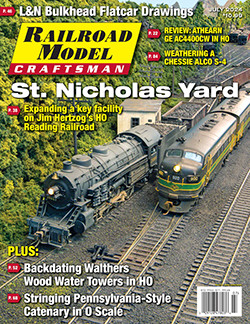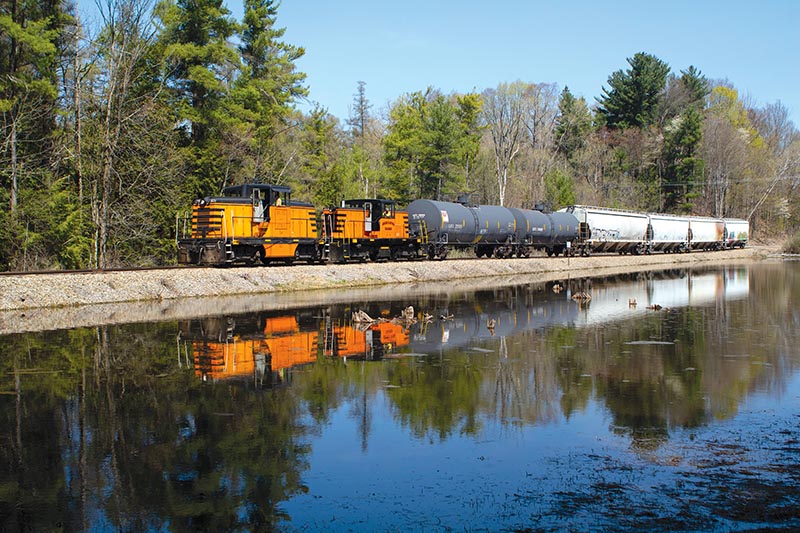 We all get the inspiration for our modeling from somewhere. There’s often no better way to get the creative juices flowing than by spending a few hours trackside. In stark contrast to busy main lines that are dominated by widecab diesels hauling long intermodal trains on smooth welded rail and deep pile ballast are the numerous short line railroads that feed into the national network.
We all get the inspiration for our modeling from somewhere. There’s often no better way to get the creative juices flowing than by spending a few hours trackside. In stark contrast to busy main lines that are dominated by widecab diesels hauling long intermodal trains on smooth welded rail and deep pile ballast are the numerous short line railroads that feed into the national network.
One appealing aspect of short line railroads is often how accessible the operations are. A friendly approach at the main office or engine house is often enough to gain access and learn more about the day’s activities and operations. On more than one occasion, bringing coffee and donuts for the crew helped get a warm welcome.
Another aspect of short line railroading is how a small roster of one or two units is enough to handle the traffic. One line might have a small fleet of similar units to help improve reliability and efficiency, while another railroad might employ a rag-tag roster of motive power from different eras and manufacturers. Some railroads invest in attractive paint schemes, while others simply cross out the previous owner’s name and stencil new reporting marks on the cab. Either approach gets the job done for their respective owners, and no two operations are the same.
Short line railroading is usually laid-back and unhurried, and sometimes doesn’t even run on a regular schedule. My friend Don Brown on the Ontario Central Railroad summed up his service as “one car or a hundred,” ready to serve any customer any time. Dependent on their connections to the outside world, the schedule is often determined by when interchange traffic is dropped. Some lines only run once a week, while others might run three times a week or even twice a day! Other lines are tied to a single large customer, and might only operate “as needed” when traffic levels dictate the need for a train. Sometimes the schedule is determined by other factors, especially where a handful of employees cover many jobs. When they’re not running trains, the crew might be out replacing rotten ties, another day they might be pulling a bad piston liner from the engine, and another day they might be cutting brush or repairing culverts — that’s when they’re not at the office catching up on billing and paperwork.
Unlike the main lines hosting hotshot freights doing all of 60 mph as they race across the countryside, short lines usually present an opportunity to follow a train and get dozens of photos up and down the line as the crew serves customers. By definition, short line railroads are typically under a hundred miles, with most being less than half of that, depending on the territory served. Slower operating speeds are the norm, with some trains “sprinting” along at 25 mph, or taking their sweet time at 10. Scenery can also be a draw, from lush farmland to busy suburbs to dense urban switching districts. Perhaps you’re up at sunrise, meeting the crew as they’re climbing on the engine to start their day. Some railroads “sleep in” and don’t go on duty until late afternoon. Maybe they switch every customer, or perhaps it’s a quick trip with light engines to fetch a “hot” car from the interchange. Either way, if you’re able to keep the sun to your back, you’re in for a full day of activity as crews go about their business serving the customers they know so well.
Some of my best railfanning memories are chasing short lines, and I’ve shared some of them here. My native New York state seems to have an attraction to vintage Alco diesels, from a single RS-3 working the interchange on the Batten Kill Railroad, to an RS-32 hauling a block of reefers to cold storage on the Falls Road Railroad, to a pair of Centuries bracketing a delivery to a lumber yard on the Livonia, Avon & Lakeville. The Iowa Traction Railroad uses hundred-year-old electric motors to move soybeans and scrap metal, while Central California Traction long ago dropped its wires in favor of diesel switchers. Charming operations like New York & Greenwood Lake running down the middle of the street in Passaic, N.J., are no longer there, with the tracks ripped out and their Erie-inspired Geeps sold to new owners. And then there’s New York’s Arcade & Attica Railroad, relying on a fleet of General Electric center-cab switchers to move molasses and feed stock to the mill. No multiple-unit control here: this is a true double-header with two engine crews coordinating their movement. Does it get any more down-home than the crew pausing at a local car dealership’s pump to top off the diesel?
If you’re looking for a change of pace from the large Class Ones, consider looking up the short lines in your area, and see railroading as it used to be all across the country. What will result is a good time trackside, and it might even provide some fresh inspiration for your own modeling at home.
—Otto M. Vondrak


